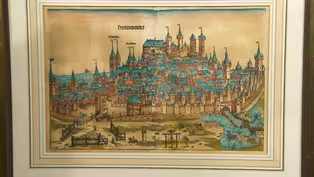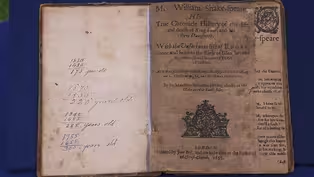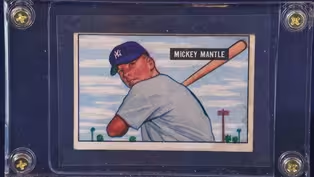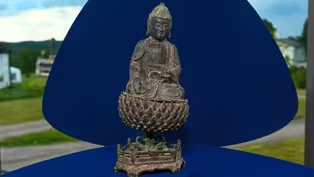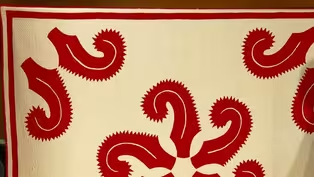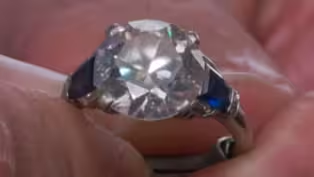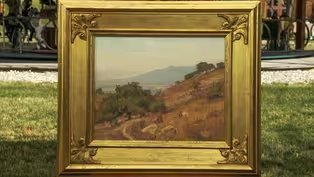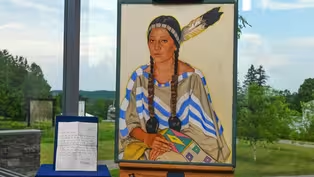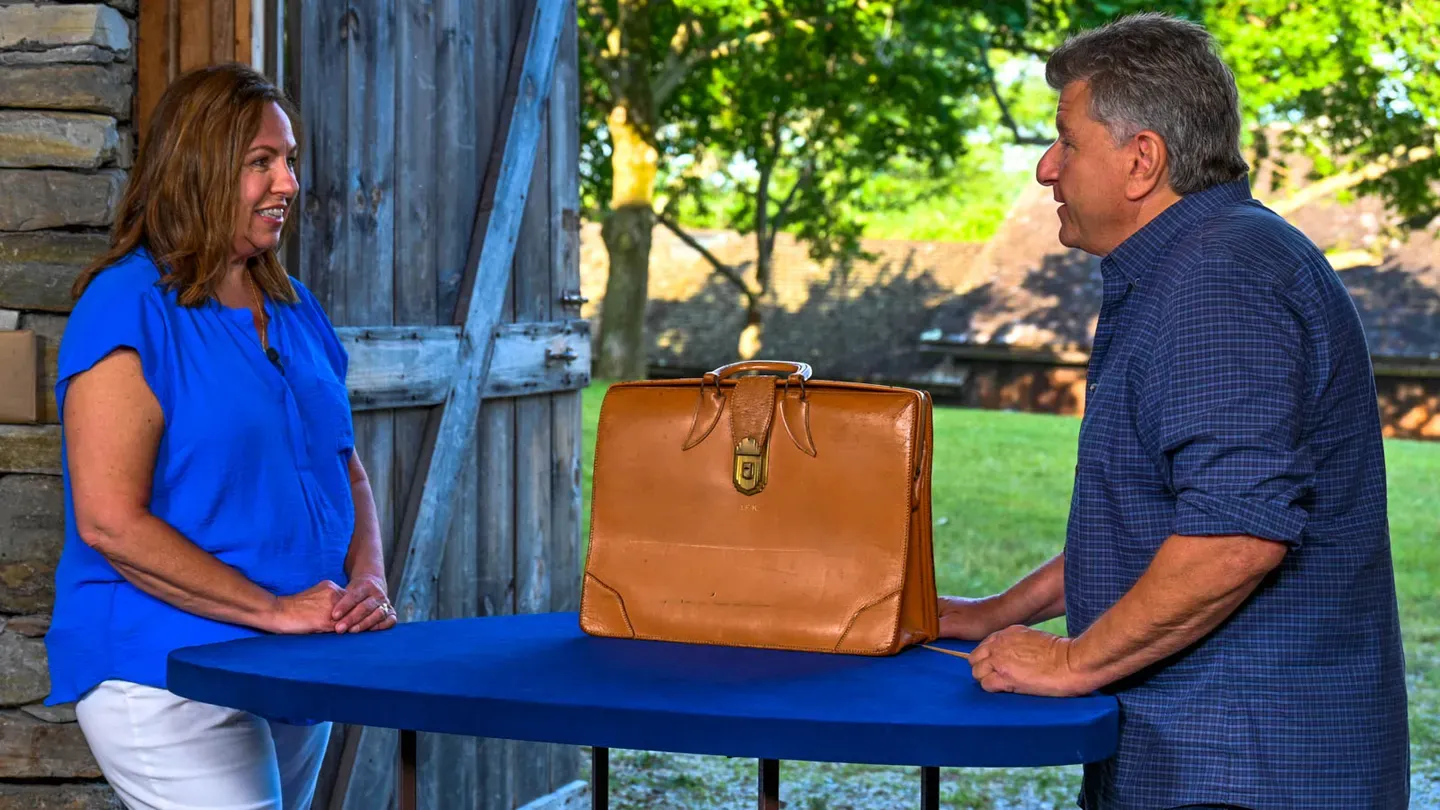

Shelburne Museum, Hour 1
Season 27 Episode 13 | 52m 26sVideo has Closed Captions
Get wowed by shocking finds from ROADSHOW's first hour at Shelburne Museum!
Get wowed by shocking finds from Shelburne Museum, including a 1999 Pokémon Card collection, Winold Reiss Morning Star mixed-media art, ca. 1934 and a Raymond Yard platinum & diamond ring, ca. 1940. Guess the find that's up to $100,000!
Problems playing video? | Closed Captioning Feedback
Problems playing video? | Closed Captioning Feedback
Funding for ANTIQUES ROADSHOW is provided by Ancestry and American Cruise Lines. Additional funding is provided by public television viewers.

Shelburne Museum, Hour 1
Season 27 Episode 13 | 52m 26sVideo has Closed Captions
Get wowed by shocking finds from Shelburne Museum, including a 1999 Pokémon Card collection, Winold Reiss Morning Star mixed-media art, ca. 1934 and a Raymond Yard platinum & diamond ring, ca. 1940. Guess the find that's up to $100,000!
Problems playing video? | Closed Captioning Feedback
How to Watch Antiques Roadshow
Antiques Roadshow is available to stream on pbs.org and the free PBS App, available on iPhone, Apple TV, Android TV, Android smartphones, Amazon Fire TV, Amazon Fire Tablet, Roku, Samsung Smart TV, and Vizio.
Buy Now
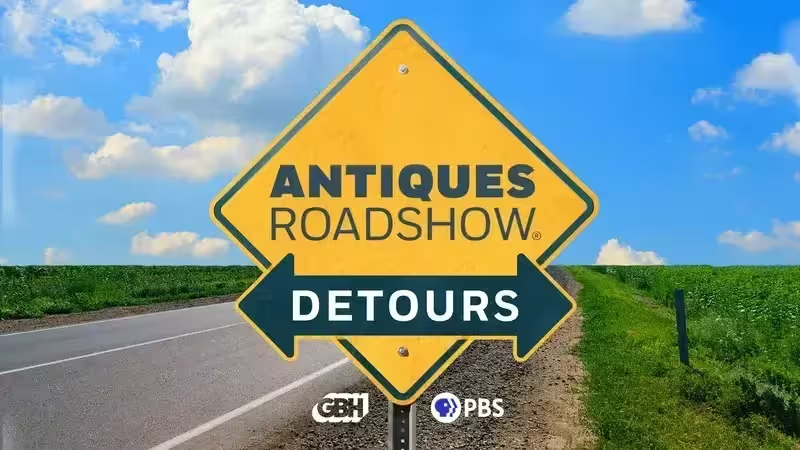
ANTIQUES ROADSHOW DETOURS
Ever wondered what happens to the treasures featured on America’s beloved ANTIQUES ROADSHOW after the cameras leave town? Host Adam Monahan tracks down the juicy afterlives of your favorite finds from PBS’s hit series.Providing Support for PBS.org
Learn Moreabout PBS online sponsorship♪ ♪ CORAL PEÑA: The treasures coming in to "Antiques Roadshow" at Vermont's Shelburne Museum are making everyone say, "Wow!"
Wow.
Wow, that's great.
Wow!
Much more than I was expecting.
(chuckles) Wow.
For this dirty little book.
♪ ♪ PEÑA: The Shelburne Museum has been called a collection of collections.
The eclectic ensemble of 19th- and early 20th-century American art, antiques, buildings, and vehicles was the brainchild of a woman of considerable means who had an inspired vision and an unextinguishable passion for collecting.
Her name was Electra Havemeyer Webb.
Mrs. Webb said she inherited the collecting gene from her parents, who favored European Impressionists and Asian art.
She followed her own tastes and interests, seeking out antique pieces of Americana.
Shelburne Museum, which she founded in 1947, is her legacy.
"Roadshow" is seeing a wide range of fascinating treasures, some Mrs. Webb would have also appreciated.
♪ ♪ Hi!
Well, I got this piece down in North Carolina.
Got it off a lady-- it freaked her out, she didn't like it.
I gave her $100 for it.
MAN: Any idea how old it is or anything?
I'd say probably 1940s.
Is it heavy?
Very heavy.
(laughs) MAN: What attracted you to this?
Looked creepy.
WOMAN: It is my great-grandmother's ring.
(appraiser gasps) And then my great-grandmother gave it to my grandmother, and she said to my grandmother, "I will only give you this ring if you wear it, because beautiful things were meant to be worn."
So she used to wear it every day, and twice she was, um, out for the night, and she was robbed, and they took tons of other stuff, and they left this ring, because they thought it was costume jewelry.
It's not costume jewelry.
Oh, ho, yay!
Yeah, it is a diamond, it is a diamond.
Okay, okay.
And it's in platinum.
Okay.
It weighs five-and-a-half carats.
It's kind of an average color, like, IJ.
Mm-hmm.
The reason it looks whiter, it has some fluorescence, which in some worlds is a bad thing, how it reacts to U.V.
light-- in this case, it's really a positive thing.
It makes the stone look whiter and brighter.
You got these wonderful sapphires and diamonds on the side.
Beneath the ring guard, it says Yard.
And Yard was the jeweler to the Rockefellers.
(gasps): No way.
Yeah, seriously.
Oh, I got a little chill.
Whoo!
Oh, that's kind of cool.
Okay.
(laughs) Okay, so cool.
So you had an evaluation on this ring.
Yes.
For?
So in the '80s, they said it was $40,000.
And then, um, in, like, 2010, they said it was around $20,000, maybe a little less, so...
Right here, right now?
Mm-hmm.
At auction...
Yes.
$75,000 to $100,000.
(gasps): No way!
Wow, that's kind of exciting.
That's kind of, like, chill-making, yeah!
(both laugh) Whew!
Okay, I need to go put it in a safe deposit box or do something now, I mean... (laughs) I've just been carrying it around in my backpack for a week.
(both laugh) APPRAISER: Dawn, I appreciate you coming in today, and we have what looks like just an average man's briefcase, but apparently it's not.
(chuckles) It's not-- this briefcase belonged to John F. Kennedy, and, um, he frequented my uncle's cobbler shop on Beacon Hill in Boston when he was renting the apartment above.
And, uh, came in for weekly shoe shines.
And when he did that, he left this there, and no cell phones back then, my uncle couldn't get in touch with him.
He came back for his, the next shoe shine, and my uncle tried to return it to him, and he said, "Oh, Charlie, I've, I've already replaced it-- just, you keep it."
And, and inside were some handwritten notes, and his lunch of a liverwurst sandwich and an apple.
And, uh, it's been in my family ever since.
We think that was in the early '50s.
And, um, it was then gifted to my father, because my uncle had no children.
And when my father took this to school, he was taking it for show and tell, and, I think, to a history class, he told me, and it came home without the papers.
So the papers are history.
The papers are history.
So we're gonna take a look inside just to see what we have.
And you can see inside we have the compartment where his lunch was...
Yes.
...and his papers.
You got that nice little deli smell.
So we know it was a liverwurst sandwich.
(chuckling) Could have been olive loaf, but not sure.
When we look at things like this on the "Roadshow," two words always come up, and that's provenance... Mm-hmm.
...and comparables.
So the provenance is great.
It's been in the family, you've had chain of custody for a long time.
His initials are right here.
So I'm fairly comfortable with the provenance as it being John F. Kennedy's briefcase.
Comparables-- that's how we arrive at value for something like this, and it's not an exact science, it's not an easy thing to do.
Sure.
'Cause you're going to find dramatic swings all over the market.
But presidential memorabilia, especially things owned by presidents, is a hot collectible.
It always has been and I think it always will be.
Especially with certain presidents.
JFK is one of the tops when it comes to value and, on items that he owned.
It's not a unique item, because there have been several records of JFK briefcases coming to market.
Uh, in '98, they did a special sale at a New York auction house with about 600 lots of items relating to JFK.
In that sale was a briefcase that was given to JFK by his dad at the beginning of his career.
It was a controversial auction.
The family claimed a lot of the things were theirs.
But that briefcase wound up in the sale, and it sold for $700,000.
Now, that's not to say this is anything like that.
When you keep doing a little more research and digging, you find other presidential briefcases that have sold.
One from FDR was around $17,000.
LBJ, around $18,000 and change.
So all of this being said, I have to now come up with some sort of value to base it on.
Obviously, this was before he was president.
Yeah.
Uh, if it was a presidential briefcase, I think the value would be higher.
But all things put in perspective, based on other auction records, I would probably put an estimate somewhere between $20,000 and $30,000.
Wow.
It's a great piece of American history-- the fact that JFK actually held the handle, he had his lunch in here.
Well, thank you very much.
No, I'm glad you came.
I, I really appreciate it.
I really enjoyed seeing this in person, it's just a great thing.
WOMAN: I brought a set of Pokémon cards.
Like most '90s babies, I fell into the craze.
We were playing with them on the school bus, trading them, and, uh, my mom bought me this set online.
My mom thought I was being taken advantage of in my Pokémon trades.
(laughing) And so she wanted to get me a complete set to save until I got older.
So do you remember when your mom purchased these cards?
My mom told me that it was sometime in the late 1990s, and that she paid about $35 for them online.
Being a '90s baby myself, the Pokémon craze was insane.
When we look at Pokémon today as a brand, as a franchise, Pokémon is an all-encompassing brand.
It's, it's unbelievable-- Pokémon is king.
Hm.
While in the United States, Pokémon was released in 1999, the original card game was released by Media Factory in Japan in 1996.
We wouldn't have the trading card game if it weren't for the original game for Game Boy, Pokémon Red and Pokémon Blue.
That Game Boy game is what sparked the initial trend.
Now, you might wonder where the name Pokémon actually comes from.
That is an abbreviation of the name for the game in Japan, which was Pocket Monsters.
So the set you have is the original 1999 what we call base set.
Base set meaning it's the first 102 cards that were released in the Pokémon game.
They were published by Wizards of the Coast.
We are focused on these two pages right here, which... Do you have any idea as to why these two pages are opened in particular?
Um, my guess would be because they have the holographic images.
Yes, the cards here that you have are the 16 original holographic cards.
In particular, you have two Mewtwo cards here.
Do you notice a difference with the two cards at all?
I notice a different shade of purple, but that's about it.
Between first edition and unlimited, there was a very small period of time where we have shadow-less.
You'll notice on this Mewtwo, has a dark border, while on this side, you'll notice it's lighter.
That's how we refer to this as a shadow-less card.
On a shadow-less card, in the lower margin, the 1999 date stamp is actually repeated.
You'll see '99 in the middle of the card, and then it's repeated all the way to the edge.
Now, grading is a very subjective thing.
I can give a grade as to what my eye sees it.
But at the end of the day, what the collector really cares about is when a card gets sent out to a third-party company.
You did take really good care of them.
They do have some light wear.
So in the world of grading, I would say they're in the 8.0, 8.5.
You might have a 9 in there, but there's no 10s, because when we look at the back, there is some very subtle wear to the blue edge.
This card right here, your regular base unlimited Mewtwo, it's about a $150 card, $200 card.
The shadow-less Mewtwo, however, easily, in its current shape, ungraded, is a $800 to $1,200 card.
Now we'll go to the king.
When it comes to Pokémon, the character that everybody loves is Charizard.
We look at your Charizard here.
Not alone is it Charizard, it is also a shadow-less Charizard.
That card alone, in its current condition, is going to be in the $2,000 to $3,000 range.
Great.
(chuckles) The Pokémon market is extremely volatile.
It is a market that blossomed through the pandemic.
I hate giving you the "womp-womp" news on the backside, but your Charizard, in this shape, less than a year ago was easily a $5,000 to $8,000 card.
And at the peak of the market, in November 2020 to March, April 2021, we were seeing this card hit as high as $15,000.
You have so many other cards.
Your Nidoking is shadow-less.
Your Gyarados is shadow-less, plus the other mix.
You have some great jungle holograms in there.
You have a lot of fossil cards in there.
There's approximately 150 cards in your binder.
Conservatively, at auction, we would say that your binder would be in the $5,000 to $10,000 range.
Wow, much more than I was expecting!
Okay!
(chuckles) What were you expecting?
My friends told me $50 for the whole binder, so... Oh, man, you need some new friends.
(laughs) I agree, they owe me.
(laughing) I don't know anything about it-- my wife knows about it.
(laughs) Hi!
(both laugh) Um, I know that my mom is from Scotland, and this has been in our house.
And it came from England, and it was in a ski condo, and when we sold the ski condo furnished, all she wanted was this out of it.
So I went and got it.
(chuckles) So this is a weathervane that might be copper or might be tin.
And my 101-year-old grandmother bought it at an auction in the '60s or '70s.
She's, doesn't remember much about it now, but she's always said that it's valuable and we shouldn't throw it out.
MAN: Today I brought in a woodblock print of the city of Nuremberg, and I believe it comes from a book from 1493.
I inherited it from my parents, and I know that they purchased the print in Germany when they lived there, uh, around 1969.
Yes, in fact, it is an original woodblock print, and it is 529 years old, which is incredible that it's survived today.
This is a bird's-eye view of the city of Nuremberg that was printed in 1493, and it's by Hartmann Schedel, and he put together the "Nuremberg Chronicle."
It was issued in 1493.
It was a compendium.
It was a religious book, but there was also a historical aspect to it, which was unusual for the time.
Anything that, of this size and quality was incredibly hard to make.
And it would have been hundreds of artisans working together to produce something so beautiful.
What I look for when I see something like this is, I look for the quality of the line.
And that's the first thing I noticed when you brought it in, the beautiful, sharp woodblock print.
The other thing that I look for is the coloring.
I was surprised to see it, 'cause not all of the "Nuremberg Chronicles" were colored.
Yeah.
Many were printed in black and white.
But with yours, the coloring is very special.
It's original color, and it's gouache and watercolor applied by hand after the woodblock print was made.
Schedel employed famous artists to make the woodblocks, and, such as, um, Albrecht Dürer.
I'm sure you've heard of him.
Yeah.
And he, so, so there's a wonderful animated quality to the city plans.
It's one of the few city plans that takes up the full page.
Many of the other plans are embedded into the text.
What's really interesting about the picture to me is that there are a few things that still exist here.
Of course, the wall is still present in Nuremberg.
A lot of the buildings in the center city are still there.
But the castle stands out.
One, because when I was in college, I actually stayed there in a hostel.
And the church spires, because those are still there, as well, as far as I know.
And you've kept it in really good condition, uh, and it has not faded at all.
The center join shows us that it's original.
Do you know how much your parents paid for it?
Several hundred dollars.
Uh, nothing... Great.
Nothing crazy.
Nothing against Nuremberg, but it's not one of the trendier cities that's asked for, but because it's the city, uh, that the book was made in, because it's the double-size folio and a full sheet, I would put a retail value on it of about $2,000.
Wonderful, that's great.
Thank you for bringing it in, I love it.
It's wonderful to look at every day.
PEÑA: The Shelburne Museum in Vermont is located upon land sacred to the Western Abenaki people which they call Endocina, or "our homeland."
Furniture pieces made by Simon Obomsawin, an Abenaki woodsman and craftsman who settled in Charlotte, Vermont, in 1875, are on display in the Beach Lodge.
I remember it in the family house above the fireplace since I was a wee little lad.
And I'm pretty sure-- I don't know, but I'm pretty sure-- it came down from my, from my grandfather.
And I don't know where he found it.
Where were they living, your grandparents?
They were living down in the Virginia area.
My parents were in, uh, Albany area.
So Walter Launt Palmer was born in 1854 and died in 1932.
And really spent most of his life and career in Albany, New York.
But his dad was a pretty accomplished sculptor, Erastus Palmer.
Hm!
So, growing up, he was surrounded by fellow artists, one of whom was Frederic Edwin Church, who was one of his first teachers.
Hm.
So imagine that.
I mean, he had sort of a head start.
And he did a lot of his formal training in Albany, but he also had a stint in Paris, and had a stint at a famous studio in New York City, the Tenth Street Studio.
Mm-hmm.
It was sort of a gathering place for innovative, avant-garde painters.
Oh.
When he was in Paris-- that's where Sargent, also, was studying, under their same mentor-- he became infatuated, like so many American artists, with the Impressionist painters.
Mm.
And Palmer went on to have a really lengthy, distinguished career, uh, working in that vein and exhibiting in the States.
This oil on canvas was probably executed in the early 1900s, 19-teens, maybe.
Oh.
As late as that.
Right during his most mature period and during the most successful part of his career.
It's a nice size for the artist.
He became so well-known for this subject, this atmospheric, luminous winter subject, that he was regarded as sort of the American painter of winter.
Wow.
Would he do it on site?
I mean, would he be out in the winter, in the snow, painting this?
He painted it in his studio, primarily, though he did make many field sketches in preparation for his work.
Ah.
Ah, I see.
So I've got a few bones to pick with the, with the painting.
Pick away.
So the frame was replaced at some point, so it's a newer frame, and the plaque was probably switched over to this frame.
At one point in its lifetime, this oil was cleaned.
Ah.
And whoever stripped the varnish, cleaned the painting, and then subsequently re-varnished the painting, they were really aggressive.
It was over-cleaned.
Oh.
As it is, a reasonable auction estimate for this painting would be $20,000 to $30,000.
Wow, that's great.
Had it not been so aggressively cleaned, I think that a reasonable expectation would have been closer to $40,000 to $60,000.
Wow-- no, that's, that's wonderful.
It's part of the family.
Well, this is what I suppose is 1850-ish.
It's an old oil lamp, and it's pounded copper.
It's got the top, and there's the, the filter of it.
This is a nice guitar.
Can you tell me how you got it?
Well, I fell in love with the Beatles, and, uh, my aunt, uh, told me that, uh, she would buy me an electric guitar.
And, uh, she did, uh, on the grounds that I never sold it.
Uh, so I promised her I would never sell it.
Played a lot of local establishments and, uh, just really had a good time.
I found it in the closet of my aunt who lived in Shippensburg, Pennsylvania, at the time.
Mm-hmm.
And when I opened it up, my heart just went pitter-patter.
It was, like, wow.
And, uh, she was nearing the end of her life.
Mm-hmm.
And I asked her if I could have this after she passed, and she said I could.
Pretty much, it's been wrapped up in a pillowcase for a while.
Mm-hmm.
There are a lot of hearts in here, and I didn't know if the hearts mean anything in a kind of quilt like this.
I felt the same way you did when you opened it up at the table.
It's an extraordinarily beautiful quilt.
It's extremely graphic.
You know, you've got this bold, red center in the princess feather design with a reverse appliqué here.
And it's very unusual that they also did the corners, the four corners of the quilt, with the princess feather.
Whoever did this had a tremendous artistic sense.
That's the person who created the top.
Generally, they were quilted by a group of women in a quilting bee or a quilting society, where they would have the large quilting frame that they could put it on.
You had mentioned the hearts, and it's, there are hearts quilted throughout this piece, almost in a four-leaf-clover pattern.
There's groupings of four hearts here.
Then again, repeated again, and that's just a really lovely touch.
It's very finely quilted.
Very tiny little diamonds all the way through it, which is another thing that really sets it off.
The design is so graphic and modern, and yet the quilting, it does date it back to the 1880s or late 19th century, when it was probably made.
We can't be positive because there's no dating on it, but it's just a spectacular piece of work.
Is this, uh, typical of that time or the amount of, um, intricacy that goes into it?
In, uh, in the really good, high-quality quilts, yes.
Ah.
The pattern itself is not typical for that time.
Uh-huh.
You know, it's very unusual.
I think it's probably an original pattern.
You know, you see the princess feather, but generally on a smaller scale.
Right.
Quilts have gone up and down in value.
They were much higher in the '80s and '90s than they are now, but they are continuing to rise again.
So I would put a retail value on this quilt between $3,500 and $4,500.
And it could go higher if all the cards land in the right place.
(chuckles) Okay?
Okay, great, that's wonderful.
It's a beautiful piece.
Oh, thank you.
And it's in great condition.
Thank you, thank you.
You're a lucky man.
I am.
My brother received a phone call from a lawyer, and the lawyer said our half-sister Phyllis had passed and left her estate to my brother, my sister, and myself.
She lived in Sedona, Arizona, so, um, I was the one that went to Arizona and went to the house.
And then I went into the bedroom, and on her side table was this lamp.
(chuckles) So I knew immediately that it was pretty special.
And we found markings for Tiffany and Company.
So the poppy was a very popular design, and it did come in a number of different, uh, sizes and shapes.
Th, this is what they would call the 20-inch cone.
All right.
And th, this was first introduced in their 1906 catalogue as poppy cone.
It was sold by itself, um, and, and actually, when you went to Tiffany Studios in 1906, uh, you could pick your own shade and your own base.
And... Oh, they weren't a, a pair.
No, they... Well, there were certain lamps that were only sold as single units, but something like this would be, you'd pick the shade and the base yourself.
Shade and the base.
And what Tiffany realized very early on is that people have different budgets and different tastes, and so that gave them an opportunity to make the pairing that they wanted if they went there.
Mm-hmm.
Um, what's interesting, though, is, your base was not made in 1906.
Huh.
Your base doesn't appear in the Tiffany catalogue until 1910, and then again in 1913, and the shade was still in there.
Mm-hmm.
Um, so that it, this, in all likelihood, I do think that these two came together... All right.
...uh, for a very specific reason, um, the... Well, two reasons-- one, the g, gilded finish that you see.
Um, also the way the shade is signed, because the interior of the shade says "Tiffany Studios N.Y." and then the corresponding number that you would see in the catalogue.
Right.
Well, they didn't sign those that way until after 1910 going forward, so that would have put this shade...
Shade... ...with that base.
...with the base.
So, at the time, the shade would have cost, uh, by itself, $115... Mm-hmm.
...and the base would have cost $45.
All right.
which is not an insignificant amount of money.
Right, for that time period.
Tiffany actually put a gilded finish on these bases with 24-karat gold, so this is very expensive.
Oh.
And because it was expensive, right from the get-go, there was an additional 25% on top of the price of the lamp.
25%?
So this lamp would have actually cost $200.
All the parts are, are original with the exception of the sockets, and back then, it was more important that the lamp worked.
Okay.
But collectors today want the original parts.
So in today's market, um, I would put an auction estimate of $70,000 to $90,000 on this lamp.
Oh!
Very nice.
And, uh, it's, it's really a really fine example.
Yeah, it, it, it was found in a, uh, in a, uh, abandoned home that, uh, was owned by somebody who could very generously be described as an undisciplined collector.
(woman laughs) So it is very dusty.
And my grandmother, when she was a little girl in the early 1900s, would hop in and out of it.
This was in my grandmother's house outside of Boston.
And, uh, when she died and we were breaking the house up, my dad said, "Remember the Indian basket under the stairs."
She acquired it from her mother, uh, my great-grandmother.
And, um, it, my great-grandmother had received it from an admirer.
And, um, my grandmother always remembered popping in and out of the basket.
My grandmother, actually, today is her birthday, and she was born in 1904.
So this has been in your family for quite a while.
Right.
This basket speaks of the turn of the century, so it was probably created about 1890 to 1900.
It's called an Apache oya, and the term "oya" is a Spanish word for jar.
Hm.
So the Apaches used this for grain storage.
Ah.
This is a masterwork by the Apache of the American Southwest.
And so there, it's from Arizona from the time period that they were making them for grain storage.
Hm.
They were masters at achieving symmetry and decoration.
As the tourist trade started to open up, they would actually make them bigger and taller.
I love the little, I don't know if it's a horse or a dog.
It's probably a dog.
Okay.
With the tail up, probably it's a dog.
Okay.
And men, um, on this, as well as the geometric patterns.
It's in remarkable condition.
It's, it's a little dusty.
But that... (giggles): Yeah, that's because we put it up high to k, keep it away from kids and a cat.
Right.
(both laugh) And, which is fine, and that can easily be corrected, but it has a lovely t, appearance.
The form is exquisite, but they're incredibly heavy.
And that's, um, when you carry them, you need to carry 'em by their bases.
Right.
'Cause you grab it by the rim, you might end up with the full section of the rim in your hand.
Have you ever had it appraised before?
No, and, you know, it's actually always just been a backdrop of my life.
It's just, to me, it's just, like, it's a practical thing of beauty.
And no one ever came in the house and said, "Oh, my gosh, do you know what you have there?"
(chuckles) No, because, um, honestly, I, we were kind of busy raising kids, and I just needed to make sure that it was okay.
Well, if this was to come to auction, on a sophisticated marketplace, it would sell for about $15,000 to $18,000.
Wow.
That's really something.
It's really gorgeous.
Yeah.
I mean, the form on it is exquisite.
I love the aged look on it.
It has a, a, it has a lovely... Patina.
(both laughing) Has... You've been watching the "Roadshow," haven't you?
Yeah.
PEÑA: Mrs. Webb's attachment to childhood treasures is evident with 40 turn-of-the-20th-century carousel figures created by the Gustav Dentzel Carousel Company of Philadelphia.
Which animal would you choose to ride?
While these colorful examples are only for admiring from a distance, outside, visitors can take a spin on the 1920s carousel made by the Allan Herschell Company of North Tonawanda, New York.
ALL: "Antiques Roadshow"!
♪ ♪ MAN: My sister gave it to me about 12 years ago.
And she gave it to me because I had a close relationship with my brother-in-law.
He died at 53.
And she kept the card.
It's very special because I got it from her.
When I was young, baseball was a big deal for me, and I played for the Yankees.
In, uh... You did?
In, uh, in Little League, yes.
Ah!
In Little League, and I wore number seven.
I think he had number seven, wasn't it?
Mm-hmm.
And then my dad took me to a Yankees and, uh, Milwaukee Braves game, World, World Series game.
And Mickey Mantle was my hero at that time.
Mickey Mantle was really, post-World War II, that era, he was the first baseball icon, right?
Yeah.
He was the center fielder for the New York Yankees, he succeeded Joe DiMaggio.
And they won all these great championships with him in '51, in '52... Yeah, they won... ...'53, '56, '58.
They won every year.
You know, '61, '62.
And he hit home runs.
He was exciting, he was fast.
Yeah.
In the c, world of sports cards, this card is probably one of the top five... Yeah.
...that are collected today.
Bowman created the 1951 series.
They originally had 252 cards.
Uh-huh.
And they decided to add another 72.
And aren't we lucky, because 253 is Mickey Mantle.
And later on... Oh, I see.
...they also added a Willie Mays.
So the higher-number cards-- they only come out for part of the year-- they're much scarcer.
Yeah, really.
This is Mickey Mantle's card from 1951.
Yes.
That's when he came up with the Yankees, the only year he played with Joe DiMaggio.
And he was known as the Commerce Rocket because he came from, from Commerce, Oklahoma.
Oh, I see.
And came up to the Big Leagues.
Yeah.
And immediately electrified the Yankees.
He had one spell in the minor leagues.
His father came and talked to him and actually said, "I'll take you home."
And Mickey said, "No, no, no, no, no."
And he decided to go back to the Yankees, had a fantastic year until he got hurt in the World Series, and then had a tremendous career up until he retired in 1969.
The best-known post-World War II card is the s, '52 Topps card of Mantle.
But this is Mantle's true rookie card.
Yes.
So that is, right after the Topps card, the most collected after Honus Wagner.
So I'd put it on a scale, um, Wagner first, '52 Topps Mantle second, '51 Bowman Mantle after that.
But grading is really important.
Cards are graded on a scale of one to ten nowadays.
And I have to tell you, unfortunately, this is in tough condition.
It is?
This is not great condition.
The margins are not even here.
Mm-hmm.
You've got soiling that's happened all over here.
And then if we flip this around, you can see that the entire back has been soiled, okay?
So it's not the best example, and in fact, I'm not a professional grader, but if this card was graded, it would probably come out a 1 or a 1.5.
That's not good, is it?
(chuckles) It's all, that's all the bad news.
I'm giving you all the bad news first.
So have you ever had this valued?
Have you ever had it appraised?
Well, my sister did before she gave it to me.
Okay.
I think she found at that time it was worth maybe $3,500.
Okay.
Yeah.
Well, now I've got some good news for you.
That's good.
So even in the condition that this is in, poor condition, this is such a desirable card by collectors that I would put an auction estimate of at, of at least $8,000 to $10,000.
Wow, yeah, that's good, yeah.
(chuckles) That, that's, that's pretty good appreciation, isn't it?
I never seen this program.
My friend Lynn invited me to this program, and I said, "Yeah."
She got two tickets.
Was it worth the trip?
A good program.
I may even watch it, watch it now.
(laughs) MAN: Well, I brought a book that was part of a collection that my grandfather amassed when he was an architect in Michigan.
And it's just been coming down through the family.
A very eclectic collection, but this is one that I thought was, was more interesting.
It's a, an edition of William Shakespeare's "King Lear."
So what you brought is the third quarto edition of "King Lear" by William Shakespeare, uh, printed by Jane Bell in 1655.
Hm.
Quarto refers to the way the paper is folded, and it makes a small square book.
Oh, okay.
Mm-hmm.
And the quarto plays are sought after by collectors because they were ephemeral and small and cheap, and therefore don't really survive... Mm-hmm.
...but are much more the authentic Shakespearean... Hm.
...um, almost like a souvenir that you might buy after seeing a play.
Uh-huh.
There are three quarto editions in the 1600s of "King Lear."
The first one was printed in 1608.
Okay.
The second one was in 1619.
And this is the third.
The third, hm.
This one kind of gets a bad rap.
Uh, Jane Bell, kind of a bit of a pirate.
Not really sure if she had the right to print it.
A-ha.
It was the widow of a printer named Moses Bell, and she had rights to print something, but maybe not this, and, um...
Does that apply to the third printing or the...
Yes, yeah, her, her printing.
Just-- okay.
Because they did actually have to have rights to print things.
Mm-hmm.
Even though it was the 1600s.
But so her text is kind of corrupt.
This book doesn't look that great, right?
Looks a little brown.
Well, it's... Seen some years.
We had some trouble setting it up because the front board is detached, and this has a piece of tape on it.
So you think, "That looks like a junky book."
I noticed there are a lot of numbers over here on the other side-- it looks like people are practicing their math skills.
Looks like they're trying to figure out how old the book is at different points, which is kind of interesting.
This is actually a later binding.
This is not the original binding... Oh, really?
...from 1655.
So it doesn't affect the value because a collector would have this book resewn and rebound in a more period-appropriate binding.
When I was looking it up, I found that the last copy of the 1655 Jane Bell quarto "King Lear," as you have here, that sold at auction sold in 1946.
Really?
And nothing since.
Wow.
Nothing since.
And before that, there was a dealer's catalogue, maybe from the '20s, nothing else.
Hm.
So then I looked it up in a bibliography to see how many copies there are in libraries, and there are only ten copies in the U.S. Really?
And seven in England, which is also really rare.
Wow.
Shakespeare collectors are really serious.
Collectors of English literature are really serious.
They don't mind a little condition problems when it comes to Mr. S., you know?
Mm-hmm.
Know what I mean?
Um, it's an amazing book.
It's, it's a great find, and it's hard to establish, obviously, if you have a book that hasn't been sold since 1946.
Yes.
We often rely on auction records... Mm-hmm.
...to look for comparable copies to figure it out.
This book is complete.
I went through and checked all the pages, so it's all there.
Mm-hmm.
At auction, I would conservatively say $10,000 to $15,000.
Really?
Yes.
Wow.
For this dirty little book.
Well, I knew it was unusual, but I had no idea.
It belonged to my great-grandfather, and that's really all I know about it.
I know that we've never been allowed to sit in it, uh, because it was old.
My uncle picked this up in his travels.
He lived in Vermont for a few years in '68.
Well, I think, like, '65 to '68.
Went to UVM-- got it from him.
MAN: What's the penalty for stealing an Air Force sign?
(laughing): Well, me, too.
We joked about that.
(laughs) Yeah, he passed.
He would love this, that people are excited about it.
WOMAN: This painting, uh, has been, um, hanging in the house, childhood house that I grew up in here in Vermont my entire life.
Before that, uh, my father inherited it from his grandmother, and it hung in, uh, her house for his entire life.
And I believe it came from their family friend, um, William Wendt.
Who was the artist.
Who was the artist.
Uh, that painted this wonderful painting.
So I noticed there's a letter attached to the back that's dated 1937.
Uh, it, it indicates that it was purchased.
It doesn't say the amount, but do you remember what it was purchased for?
I don't think we have exact record for what it was purchased for, but my great-great-uncle did purchase this directly from William Wendt for a couple of hundred dollars.
And we believe it was, uh, as a gift, or intended for a gift, uh, for his sister, my great-great-grandmother.
It basically talks about the relationship that William Wendt had with my family.
Uh, apparently he became a family friend acquainted from his wife, Julia, who went to, uh, the Chicago Art Institute with my great-great- great-aunt Bertha.
Ah.
William Wendt was born in Germany in 1865.
He immigrated to the United States in 1880, so he was only 15 years old.
He died in Laguna Beach in 1946.
He actually moved to Laguna in 1918, and that's when he set up, uh, his, uh, studio there.
And I know this painting is actually purchased through that studio, so that's a, a really kind of a cool thing.
He's known as a landscape painter that actually painted a lot of California landscapes.
And this is a California landscape.
Very nicely done.
It's an oil on canvas.
It measures 16 by 20 inches.
And it's signed down here.
It's kind of close to where the, uh, frame hits, but it's signed "William Wendt."
It's not dated, so I have to estimate the creation date, which is roughly, I would say, 1920, somewhere in that area.
I've always loved this painting.
And do you have any sense of what you think it might be worth?
(chuckling): Um, no, but I know that my father, um, would tell my brother and I as children that, uh, in the event of a fire, grab this painting first and then exit the house.
(both laughing) Get the priorities straight, right?
(laughing): Yeah.
Yeah, so I would estimate this to be worth at auction between $15,000 and $25,000.
Wow, great.
Good job, Dad.
(both laughing) It came from my parents' house.
They had traveled to, uh, China previous to World War II, I believe.
I was studying Buddhism in college around 1973 or so, and I asked my mother if I could have it, and she said, "Yes, take it."
And it's been with me ever since.
Here we have an object created for veneration that looks like it's been everything but venerated.
(chuckling) (chuckles) Right?
Venerated roughly, yes.
It's been very roughly handled.
Mm-hmm.
And you wonder how did something go from being highly esteemed to something that is leaning?
Mm-hmm.
And the very best you could say is highly marred.
Yeah.
There's a bowl in there.
Um, maybe an incense burner, or some other kind of... thing.
I'm going to lift this up so everybody can see.
Mm-hmm.
It's actually in three parts.
So you have this figure, which is really heavy.
And I'm going to put it down here.
And then you have on the inside this, this is what you're referring to as the bowl.
Mm-hmm.
And then you have the base.
Mm-hmm.
So I'm going to put this back because it's too heavy for me to hold, but we're going to address each of these aspects.
So one of the things you were a, you were asking about, was this used as an incense burner, which might cause some of the things that we're looking at?
Yeah, yeah.
And the answer to that is no.
No, okay.
Okay?
(chuckling): Yes.
It is a base.
I mean, yes.
Now, it's hollow-- why would it be hollow?
Mm... don't know.
Because if it were solid, it'd be enormously heavy.
Oh, yes, of course.
And incredibly unwieldy.
Yeah.
And even as it is, you can see it's leaning.
So just imagine this as h, as solid.
Yeah, yeah.
So it's providing a platform for what is raised and elevated, because it is important.
Mm-hmm.
Which is the figure.
So we start at the bottom.
What you have here is essentially a walled garden.
And then rising from the water, you have this lotus pod... Mm-hmm.
...that is oversized, which, this is representative of peace and tranquility.
Yeah.
And an association with a world that's better than the world we're in.
Mm-hmm.
And seated atop this is this figure with a calm, meditative pose.
So one of the symbols of peace is right here emblazoned over the heart.
Mm-hmm.
The wan symbol, which is a symbol for peace.
People mistakenly refer to this as a swastika, but this has traditionally been a symbol for tranquility.
It's, uh, this age-old symbol.
In the 20th century, it was misused during World War II.
Mm-hmm, mm-hmm.
It is worth noting that the Germans flipped it around and made it spin the other way.
Yes.
We would refer to this as a figure dating from the late Ming period.
Mm-hmm.
And we can say that because there are certain elements of this that display a little naïve treatment, a roughness in the treatment, the green patination, this kind of accretions on the surface, which one has to say, "Okay, what are those?
Where did that come from?"
So it may have been something that was adhering to a material that was over top of it.
Mm-hmm.
Which could have been a burgundy kind of colored lacquer that was infused with gold.
Or it could have been any number of things, that somebody maybe had painted it a different color or covered it to protect it during a time where they didn't want it stolen.
Mm-hmm.
Today, I'm sure you want to think about, what is it worth?
Sure.
What do you think it's worth?
(clears throat) I don't know.
Uh, I would start at $10,000.
Just picking it out of the air.
I think you are right on target.
I think it's $10,000 to $15,000 at auction.
Really?
I do.
In this condition?
In this condition, I do.
Because people are looking at it today as the potential to bring it back to what it was.
I'm not sure I'd do that.
I, I like the... (laughs) And that is a wonderful statement, because what some people see in the surface is just what life does to all of us.
♪ ♪ PEÑA: This rare pair of portraits of Nancy Lawson and her husband, the clothing merchant William Lawson, were created in 1843 by artist William Matthew Prior.
The Lawson portraits show off the couple's elite status as free Black people.
Mrs. Lawson wears a fine green dress and white bonnet, holding a book to indicate her education.
And Mr. Lawson sports a handsome suit and watch chain, and holds a lit cigar indicating his business success.
Prior and the Lawsons likely shared Millerite connections, a 19th-century religious movement that believed the world would end on October 22, 1844.
♪ ♪ Over here is an illustrated letter by, uh, Cliff Westermann, who I guess is better known in the art world now as H.C. Westermann.
He was a friend of my parents.
They all went to the School of the Art Institute in Chicago back in the early 1950s.
Cliff actually was about ten years older than my parents, because he was a veteran of both World War II and the Korean War.
Mm-hmm.
So he was at the School of the Art Institute on the G.I.
Bill.
He was always unique, and he was a unique student, but, um, a very kind and generous man.
My, uh, parents tell a story about being a figure drawing class, and they were all drawing the model, and he was drawing a coyote.
(both laughing) So he, he was very unique, but also very serious.
The photograph here is of Cliff in his studio... Mm-hmm.
...on North Avenue, right around the corner from where my parents lived.
This was sent to my parents as a Christmas card in 1962.
Mm-hmm.
And so that's the same year as the letter.
Yeah.
And this is just a small group of the collection.
Yeah.
So we just picked some, a few interesting things to sort of talk about.
Mm-hmm.
One of the things I really like about Westermann is, he was kind of a dichotomy.
You mentioned his service in World War II and the Korean War.
Mm-hmm.
And he was, when he was in the Marine Corps during World War II, he was in the Pacific arena, and he was on the U.S.S.
Enterprise.
Mm.
And he was, he was in some big battles.
Mm-hmm.
He was really changed by those experiences.
One of the things he writes about is being a gunner... Mm-hmm.
...uh, on the stern of the Enterprise, and he's sitting there doing his gunner duty, and this kamikaze pilot is coming in towards him.
So he's trying to shoot this plane down... Mm.
...before it hits the ship.
And he hits it, but hits it in such a way that the, the plane sort of veers off and hits the bow of the ship.
Mm.
And he's sitting there at the gun, but can't do anything about it.
Mm-hmm.
And so you end up with a man that's, he's really kind of two people.
On the one hand, you have this wonderfully illustrated whimsical letter.
"I just thought I'd drop you a little note," he says in, in the writing.
And then zhoom, here's this air mail sort of piece that he's written up.
It's very cute, it's very cartoonish.
He talks about the "kiddies."
I'm assuming that's you and a sibling.
Mm-hmm, my sister, mm-hmm.
So, very light-hearted.
On the other side, he was very concerned about sort of the helplessness of the human condition, and the way humans were being overtaken by machine.
Mm-hmm.
And everything was becoming depersonalized.
And he's best known for his sculptural pieces, some of which were fairly small and some of which are life-size, as you can see from our picture of him standing next to two of his robot creations.
I love this because you get to see a sense of what he was working on, and they're beautifully crafted.
Mm.
Um, and I think the dichotomy comes out best when you look at the Christmas card.
(excitedly): "Merry Christmas and Happy New Year," it says.
(chuckles) The image, which is actually a linocut, is part of a series he did, "Disasters from the Skies."
(laughs) And all of the images are planes, rocket ships, rockets, crashing into buildings and people.
That dichotomy is something that really comes out in your little collection here.
And that's one of the things I really love about it.
And this is a print that's come up multiple times... Mm-hmm.
...as have many of the s, the images from this series.
Uh, and generally speaking, at auction, they bring between about $2,500 and $3,500.
Mm-hmm.
Um, so they do quite well.
Mm-hmm.
Now, the letters, uh, I mean, obviously, this is a one-of-a-kind piece.
Mm-hmm.
And these do quite well.
It depends on how detailed they are.
If they're very colorful.
So this is a fairly simple one.
Mm-hmm.
But even as a simple one, you're probably looking about $4,000 to $6,000 for it at auction.
Mm-hmm.
So it's a wonderful grouping.
Thank you.
WOMAN: My grandparents were married in 1934 and Winold "Reese," the painter, gave this letter and this painting to them.
Um, the letter's a little il, illegible, but basically it's a...
It's a little hard to read.
But basically it, it just explains to them to enjoy Glacier Park this summer and congratulations on their wedding.
Is the letter dated at all?
Um, yes, 1934.
Mm-hmm.
And that's when he gave the painting to them for their wedding.
All right, so I think it's fair to assume that it was done probably in the preceding year or so.
Yes.
So the ear, early 1930s.
What do you know about the artist?
Well, I know Winold "Reese" was a pretty big painter Of the Blackfeet Indians.
I believe, I've been told it's Winold "Rice" rather than "Reese."
Oh, "Rice."
I had a time when I used to say "Reese," as well.
He came to the United States in 1913, when he was 26 years old, and brought with him a Modernist sensibility and a very broad German accent.
He had the immigrant experience, so he, he embraced the concept of otherness.
And I think that drew him to people who were more in the margins of mainstream society.
And, in this case, he did the Indigenous peoples.
Do you know who the subject is?
Her name is Agnes.
Morning Star, I believe, was her Indian name.
And I see there is a little note on the back that describes her as a woman of "grace, beauty, and education," and I...
Yes.
I feel that come through in, in the portrait, too.
Yes, very much so.
And you can see in the painting, as well, there's a great deal of empathy and respect for the subject.
Mm.
Did you do any research into his movements in the United States, or do you know where she would have been located?
Um, out West so, Midwest.
Well, more specifically, Montana.
And he started going there in 1920 and went there from 1920 to 1948.
And he was sponsored by the, the Great Northern Railroad.
And they would use images like this for marketing, for calendars, that kind of thing.
They'd turn them into lithographs.
He was quite the Renaissance man, because he didn't just do paintings.
He did interior designs.
He designed furniture.
Wow, I didn't know that.
He did posters.
He did book illustrations.
I...
He did all these things.
And, of course, he was a magnificent painter, too.
The blue and white is, is gouache.
The rest of it, the, the face and here is pastel, so it's mixed media.
Okay.
And he's done it on a Whatman drawing board, which he typically, typically used, as well.
Yeah.
So this is very characteristic of his work.
Uh, but it's wonderful to have it with the letter.
Yes.
That's great provenance.
Yeah.
And I know this has been illustrated in books, as well.
At auction, I feel pretty comfortable in giving it, uh, an estimate of $50,000 to $80,000.
Oh, my gosh!
(laughs) Really?
Yeah, absolutely.
Wow.
(chuckling): That's exciting.
Wow.
I don't think you should insure it for anything less than $100,000.
Wow, really?
So I would get that on your insurance policy.
Oh, my gosh, okay.
(laughs): I will do that.
Okay.
Yeah.
I've always loved it, so... Really made my day, so thank you.
Thank you!
PEÑA: And now it's time for the "Roadshow" Feedback Booth.
I actually brought this in case there was a snowstorm, but since there's not, it does fold out to be a chair.
It's worth about $300.
We got a dollar appraised that was my grandfather's.
Si-- he was 101st Airborne.
It was signed by his unit in his plane before they jumped on D-Day, and it's worth $600 to $700, I found out.
(chuckles) I brought my grandfather's ring.
I brought a, uh, piece of silver, uh, from my parents.
And I found out that, uh, I do need to call the insurance agent as soon as we get home today.
And I don't need to call the insurance agent because mine is, uh, less valuable than the story behind it.
And I brought my blue Mason jar.
Everyone said, "Why are you bringing a blue Mason jar?
They are a dime a dozen."
Well, this one's worth $600 to $700.
We brought two things to get appraised, but found out only one thing is priceless.
(chuckles) And we found out that our Mayan bowl is real.
It rattles on the inside, but it's not worth as much as my antique husband!
Almost lost my hat, but I didn't lose my shirt.
(both laughing) Well, thank you, "Antiques Roadshow."
We had a great time.
PEÑA: Thanks for watching.
See you next time on "Antiques Roadshow."
Appraisal: 1493 Hartmann Schedel Nuremberga Woodblock Print
Video has Closed Captions
Clip: S27 Ep13 | 2m 56s | Appraisal: 1493 Hartmann Schedel Nuremberga Woodblock Print (2m 56s)
Appraisal: 1655 Shakespeare "King Lear" 3rd Quarto Edition
Video has Closed Captions
Clip: S27 Ep13 | 3m 26s | Appraisal: 1655 Shakespeare "King Lear" 3rd Quarto Edition (3m 26s)
Appraisal: 1951 Bowman Mickey Mantle Baseball Card
Video has Closed Captions
Clip: S27 Ep13 | 3m 50s | Appraisal: 1951 Bowman Mickey Mantle Baseball Card (3m 50s)
Appraisal: 1962 H. C. Westermann Letter & Linocut Print
Video has Closed Captions
Clip: S27 Ep13 | 3m 54s | Appraisal: 1962 H. C. Westermann Letter & Linocut Print (3m 54s)
Appraisal: 1999 Pokémon Trading Card Collection
Video has Closed Captions
Clip: S27 Ep13 | 4m 12s | Appraisal: 1999 Pokémon Trading Card Collection (4m 12s)
Appraisal: Apache Olla, ca. 1895
Video has Closed Captions
Clip: S27 Ep13 | 2m 38s | Appraisal: Apache Olla, ca. 1895 (2m 38s)
Appraisal: Chinese Late Ming Dynasty Buddha Bronze
Video has Closed Captions
Clip: S27 Ep13 | 4m 23s | Appraisal: Chinese Late Ming Dynasty Buddha Bronze (4m 23s)
Appraisal: John F. Kennedy Briefcase, ca. 1950
Video has Closed Captions
Clip: S27 Ep13 | 3m 26s | Appraisal: John F. Kennedy Briefcase, ca. 1950 (3m 26s)
Appraisal: Princess Feather Appliqué Quilt, ca. 1880
Video has Closed Captions
Clip: S27 Ep13 | 2m 52s | Appraisal: Princess Feather Appliqué Quilt, ca. 1880 (2m 52s)
Appraisal: Raymond Yard Platinum & Diamond Ring, ca. 1940
Video has Closed Captions
Clip: S27 Ep13 | 1m 45s | Appraisal: Raymond Yard Platinum & Diamond Ring, ca. 1940 (1m 45s)
Appraisal: Tiffany Studios Poppy Table Lamp, ca. 1910
Video has Closed Captions
Clip: S27 Ep13 | 3m 21s | Appraisal: Tiffany Studios Poppy Table Lamp, ca. 1910 (3m 21s)
Appraisal: Walter Launt Palmer Landscape Oil, ca. 1910
Video has Closed Captions
Clip: S27 Ep13 | 2m 59s | Appraisal: Walter Launt Palmer Landscape Oil, ca. 1910 (2m 59s)
Appraisal: William Wendt Landscape Oil, ca. 1920
Video has Closed Captions
Clip: S27 Ep13 | 2m 35s | Appraisal: William Wendt Landscape Oil, ca. 1920 (2m 35s)
Appraisal: Winold Reiss Mixed-media Art, ca. 1932
Video has Closed Captions
Clip: S27 Ep13 | 3m 14s | Appraisal: Winold Reiss "Morning Star" Mixed-media Art, ca. 1932 (3m 14s)
Providing Support for PBS.org
Learn Moreabout PBS online sponsorship
- Home and How To

Hit the road in a classic car for a tour through Great Britain with two antiques experts.













Support for PBS provided by:
Funding for ANTIQUES ROADSHOW is provided by Ancestry and American Cruise Lines. Additional funding is provided by public television viewers.


